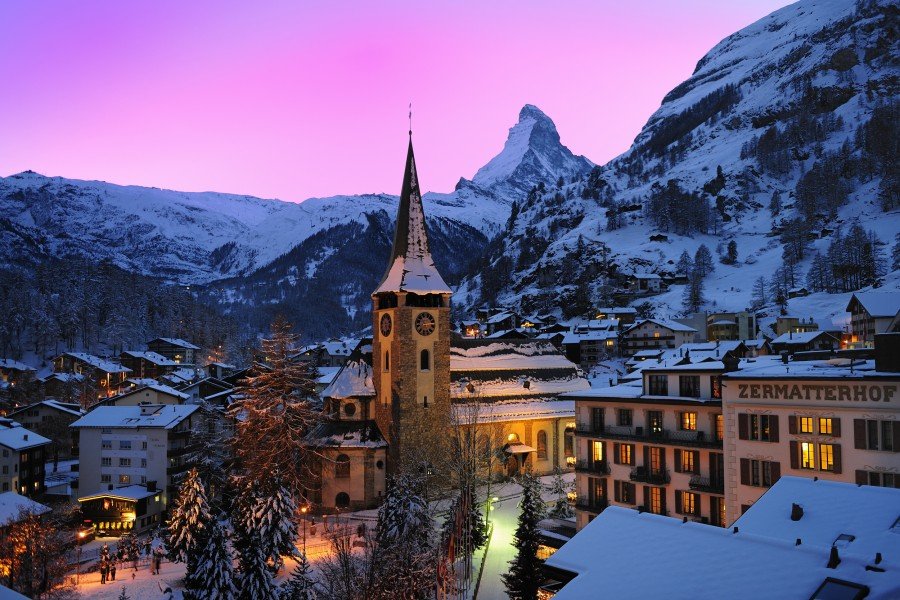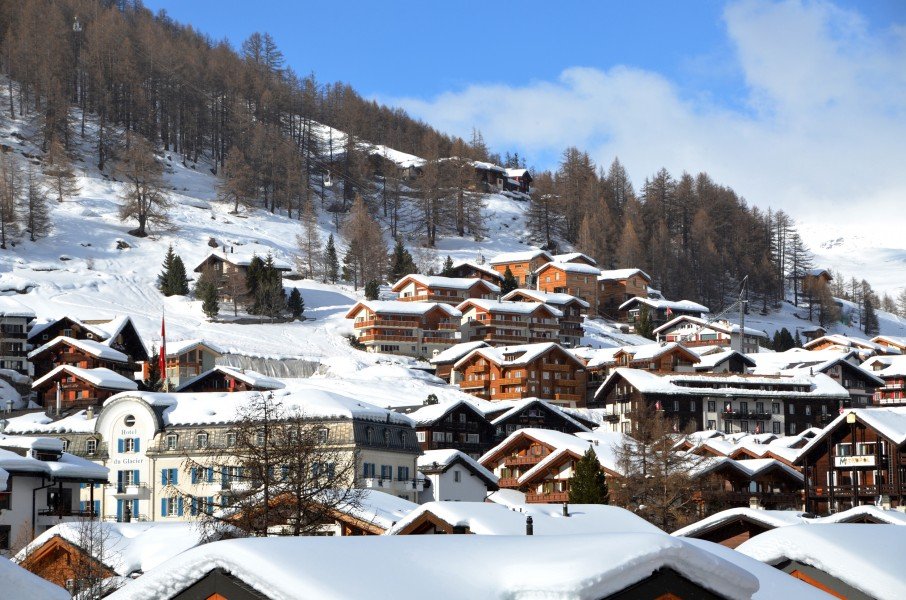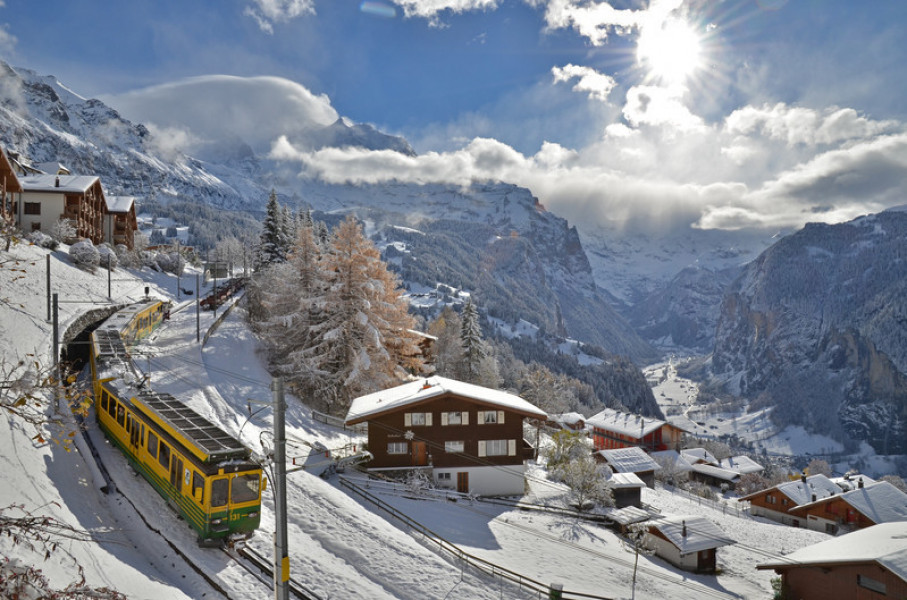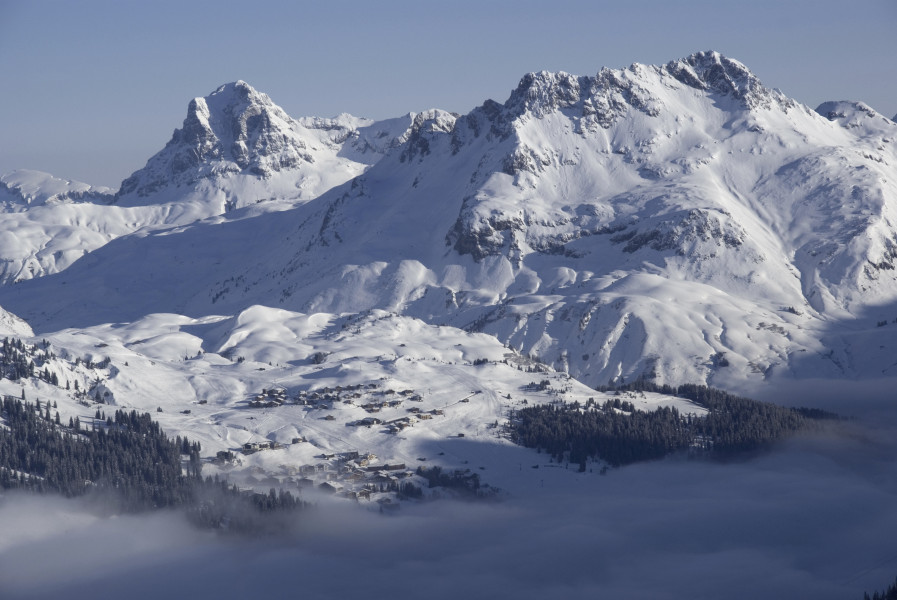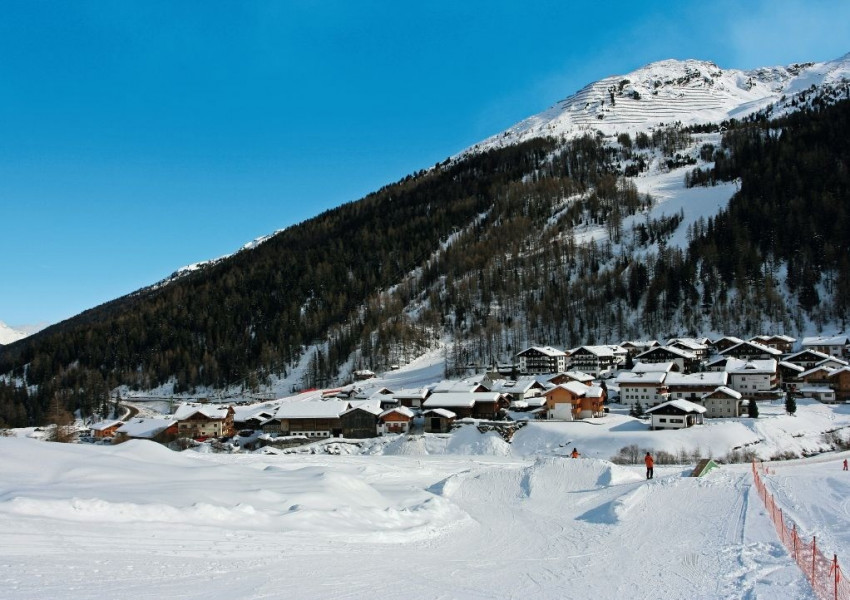More and more ski resorts are filled with pedestrians and horse-drawn carriages, rather than car noise and exhaust fumes. Switzerland in particular boasts numerous car-free mountain villages. But Austria, Germany, France, and Italy follow suit: here, too, winter tourists looking to spend their holiday away from motorcars have a range of options. Snow-online shows you where in the Alps you can get on the slopes without a car.
Zermatt
Switzerland is a bit of a pioneer when it comes to auto-free winter holidays. In Zermatt, at the world famous Matterhorn, access by car has always been prohibited. On your way there, you leave your car at the 5 km off town Täsch. From there, a shuttle train takes you to the Matterhorn village. Zermatt itself can be navigated by foot or horse-drawn carriage as well as on electric taxis or e-busses.
Zermatt is not only one of the largest (360 kilometres of slopes), it is also among the best ski resorts in the world. Located almost 4,000 metres (13,123 ft) above sea level, the highest Alpine ski resort is especially snow safe. Thanks to the glacier you can ski there all year round. A highlight even for non-skiers: Gornergratbahn cable car. The view from the top station towards Matterhorn is absolutely stunning.
Saas-Fee
When a street was built to connect Saas-Grund and Saas-Fee in 1951, the ski town decided that locals as well as tourists should have to leave their cars at the entrance to the village. Hence, up to this day you will only meet pedestrians and e-taxis. Thanks to the local glacier, skiing is possible here during 10 months of the year. Due to its southern aspect, the valley also boasts 300 sunny days per year.
Metro Alpin, the world's highest underground funicular gets you up 3,500 metres (11,483 ft) above sea level to mountain Allalin. Its peak is the highest point of the ski resort featuring more than 150 kilometres of slopes. Here is where you'll find another highlight: the world's largest ice pavilion, where you gain insight into the world of perpetual ice.
Jungfrau Region
If you're spending your ski holiday in Wengen and Mürren underneath the north face of the Eiger, you are going to park your car in Lauterbrunnen, where you have to change onto a narrow-gauge railway. Mürren – Schilthorn is the highest ski resort in the Bernese Oberland, and features 54 diverse kilometres of slopes. Grindelwald – Wengen with its 102 kilometres of slopes has a large variety, of especially red runs, in store.
On the other side of Jungfrau, cars also need to stay out: the idyllic Alpine villages Bettmeralp and Riederalp are connected to the valley with overhead railways. Once you're up there, you can hop onto the skis right at the hotel. Aletsch Arena's 104 kilometres of slopes are mainly reds and blues, making it a perfect resort for beginners, families, and pleasure skiers.
Serfaus
In Austria, Serfaus is the hotspot for everyone fleeing tailbacks and exhaust fumes. Visitors park their cars for free at the car park outside the town. A subway was built specifically to connect the car parks at the entrance with the base stations and the town centre 30 years ago. The world's only village subway runs less than a mile. In 2017, the old subway was replaced by a new one.
With its broad offer, Serfaus Fiss Ladis is among the best ski resorts in the world. Its numerous kids' areas and care facilities make it one of the most family-friendly ski destinations in the world. Wintersports enthusiasts have 214 kilometres of slopes and 68 lifts at their disposal. Most runs are marked red, and especially suited to intermediate skiers and snowboarders. More challenging black runs can be found, for instance, on Pezid or Zwölferkopf.
Oberlech am Arlberg
The hotel town Oberlech, right above Lech am Arlberg, is another quiet spot in terms of traffic. In winter, you can only make it up there via mountain railway. The local hotels and guesthouses are connected through a tunnel system. It was at the ski resort Lech Zürs am Arlberg that the first tow lift in Austria was opened in the thirties. Hence, the region looks back upon a long tradition, and is regarded as the "cradle of Alpine winter sports". Since the 2016/2017 winter season, Flexenbahn connects the resort to Stuben/Rauz, making Ski Arlberg the largest connected ski area in the Alpine republic.
Ski Arlberg is one of the best ski resorts in the world today. Sub-resorts St Anton, Lech-Zürs, and Warth-Schröcken boast a total of 305 diverse kilometres of slopes as well as a sensational 200 kilometres of off-piste runs. The offer is completed by modern lifts, great restaurants, excellent après-ski, and the two great ski circuits "Run of Fame" and "Der Weiße Ring".
Oberstdorf
In Germany, Oberstdorf banks on car-free holiday pleasure. At a size of nearly 23 ha, its town centre makes up the largest pedestrian area in the world. Within the Bavarian Alps, Oberstdorf is rather lonely in its pursuit. While other Alpine regions work towards more and more sustainability, Germany still has a bit of catching-up to do.
With a total of 130 kilometres of slopes, the Oberstdorf/Kleinwalsertal region boasts four diverse ski resorts in the German-Austrian border area: versatile Nebelhorn, family resort Söllereck, the bi-country ski region Fellhorn/Kanzelwand and Walmendingerhorn/Ifen/Heuberg with its 67 kilometres of slopes.
Seiser Alm
Beautifully situated among the jagged peaks of the South Tyrolean Dolomites, Seiser Alm is the largest high alp in Europe. Streets here have been closed to private traffic since 2004. From the valley town Seis am Schlern, Seiser Alm railway takes you upwards. One small exception is made for hotel guests: on their arrival day they are allowed to drive up to transport their luggage. Other than that, Seiser Alm is navigated on horse-drawn sleighs or skis.
Seiser Alm ski resort comprises 60 kilometres of slopes and is particularly popular among families, as most runs are classified as easy or intermediate. More demanding skiers can easily go over to the neighbouring resort of Val Gardena Gröden, which is not only among the best ski resorts in the world, but also has access to Sellaronda, the impressive ski circuit around Sellastock.
Pfelders
At the Passei Valley in South Tyrol, the little town of Pfelders is the paragon when it comes to new and innovative mobility. Since 2007, Pfelders is a "gently mobile" holiday resort. Only locals and guests staying at the local accommodations are allowed to drive. In winter, the Dorfexpress takes daily visitors to the ski slopes. The medium-term goal is to position Pfelders as the first car-free town in South Tyrol.
The ski resort features 17 kilometres of slopes, of which the majority is marked red, and therefore suitable for intermediate skiers. Another way to explore the traditional and rustic valley is on a romantic winter hike.
Val Thorens
Concepts in France differ a little from the other Alpine countries. In Val Thorens the more practical than pretty housing blocks are built in a way that you enter the underground car park, where you are within walking distance of your accommodation or the ski lift.
Val Thorens is part of Trois Vallées, the largest ski resort in the world, with 600 kilometres of slopes. It stretches over the three valleys of Belleville, Méribel, and Courchevel. Almost all of the runs are over 2,000 metres (6,562 ft) above sea level, boasting a stunning view of more than 1,000 peaks of the French, Italian, and Swiss Alps.
Valmorel

Also car-free and a bit more picturesque: the French mountain village of Valmorel at the foot of Col de Madeleine. The country village in Savoy was created artificially in the seventies, and scores with narrow alleys, a quaint market square and slated roofs. Cars are hidden in underground car parks right underneath the town.
The ski resort features 93 kilometres of mainly blue runs especially suited to beginners and families. Besides, you can explore the outdoors along numerous idyllic winter hiking trails and snow-shoe tracks.
Overview: Car-Free Ski Resorts in the Alps
| Town | Country | Region | Ski Resort | Kilometres of Slopes |
|---|---|---|---|---|
| Zermatt | Switzerland | Valais | Zermatt | 360 km |
| Saas-Fee | Switzerland | Valais | Saas-Fee | 100 km |
| Wengen & Mürren | Switzerland | Bernese Oberland | Grindelwald-Wengen Mürren-Schilthorn | 102 km 54 km |
| Bettmeralp & Riederalp | Switzerland | Bernese Oberland | Aletsch Arena | 104 km |
| Serfaus | Austria | Tyrol | Serfaus Fiss Ladis | 198 km |
| Oberlech | Austria | Vorarlberg | Lech Zürs (Ski Arlberg) | 305 km |
| Oberstdorf | Germany | Bavaria | Nebelhorn Söllereck Fellhorn/Kanzelwand Walmendingerhorn /Ifen/Heuberg | 12.6 km 14 km 36 km 67 km |
| Seiser Alm | Italy | South Tyrol | Seiser Alm | 60 km |
| Pfelders | Italy | South Tyrol | Pfelders | 17 km |
| Val Thorens | France | Rhône-Alps | Les 3 Vallées | 600 km |
| Valmorel | France | Rhône-Alps | Valmorel | 93 km |

